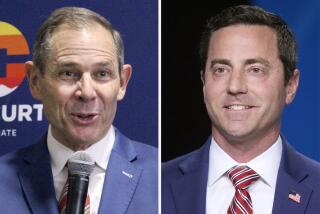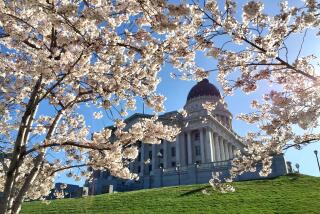In a growing Utah town, the liquor store stands alone
- Share via
ST. GEORGE, UTAH — If potential home buyers indicate they enjoy a nip now and then, real estate agent Dana Blackburn knows what to do.
“All my drinking clients, I try to get them to live on the west side,” she said as she left the lone liquor store in St. George.
There’s a supply problem facing those who imbibe in this city of 126,000, where spectacular red rock scenery, sunny weather and affordable proximity to Las Vegas have contributed to a population boom. St. George has a single state-run liquor outlet -- on the city’s west side -- and its inventory is often depleted.
In Utah, liquor, wine and beer with an alcohol content over 3.2% by weight can only be purchased in state liquor stores. State law sets the number of liquor stores based on state, not local, populations. The law says the number of liquor stores can’t exceed one per 48,000 people in the state.
“So all the liquor stores in the state could be in Salt Lake City,” said Dennis Kellen, deputy director of operations for the Utah Department of Alcoholic Beverage Control.
But the department does its best to provide the stores where they are needed, he said.
For example, the mountain resort town of Park City has an estimated population of 8,000, not enough to justify its liquor stores, Kellen said. But the city is surrounded by three ski resorts, hosts the Sundance Film Festival and has thriving summer tourism, making the two outlets there a necessity.
So what happened to St. George?
“It just got away from us,” Kellen said.
He said the department started asking for money for a second liquor store in St. George about three years ago. In that time, the city has gone from a southern Utah secret to the fastest-growing metropolitan area in the country. A Census Bureau report released this spring shows the population of St. George and its suburbs has grown by nearly 40% since 2000.
St. George was founded by Mormon pioneers as a cotton town in 1861 and served as the winter home for Brigham Young, then president of the Church of Jesus Christ of Latter-day Saints and the territorial governor of Utah.
Since the 1960s, the city has grown rapidly as a retirement area and has recently been discovered by snowbirds from other states. The population in 1980 was 13,300. Today, it is home to an eclectic mix of retirees, outdoor enthusiasts drawn to the surrounding red rock desert and members of the Mormon church -- which has a clear and widely observed ban on drinking alcohol.
Money is available for a second liquor store, but finding a location has been a problem.
The first site was nixed after the president of Dixie State College protested it was too close to campus, although it met the state’s laws on distance from schools, churches and parks. A second proposal was denied in March because city commissioners said it would be too near an area that was already congested by traffic.
The city doesn’t have to sign off on a site, but the Department of Alcoholic Beverage Control has been responsive to objections.
Last month, the department submitted a proposal for a 10,000-square-foot store, located in a commercial zone, to the St. George City Council for review, said city spokesman Marc Mortensen.
Kellen is optimistic there will be a second liquor store in St. George by Christmas. “We probably ought to be looking to ask for another store down there, knowing that it will take another three years,” he said.
The wait has been frustrating for Lee Scarlett, who manages the St. George store. The storage area of the small outlet is stacked high and wide with cases of alcohol. There’s barely enough room to walk or push a dolly through.
But within about 24 hours, he said on a recent afternoon, the stacks will have shrunk to a manageable size. In 48 hours, he’ll be anticipating the next shipment as customers start complaining that the store doesn’t have what they want.
On Friday or Saturday evenings, it’s not uncommon for a line to stretch through the store and out a back door.
“It’s been this way probably for a good year and a half,” Scarlett said. “It gets worse and worse and worse.”
For comparison purposes, the St. George store sold $32,772 worth of alcohol May 18, the state says. Another 12-hour store in Layton, north of Salt Lake City, sold about $2,000 less even though it has about 2,000 more square feet of space.
A half-hour drive south on Interstate 15 is Lee’s Discount Liquors in Mesquite, Nev. At 12,000 square feet, it’s a liquor warehouse compared to the St. George store, which is about 4,000 square feet.
Besides having an enormous selection, Lee’s has lower prices on most items and sells accessories such as lemons, limes and mixers, which in Utah require a trip to the grocery store.
Lee’s manager, Linda Donahue, said she knew that the store, which opened in October, got Utah business but the store hadn’t done any surveys to see where shoppers come from.
On a recent weekday afternoon, six of the eight cars in the parking lot had Utah plates.
Bringing alcohol into Utah from out of state is against the law -- a Class B misdemeanor charge with penalties of up to six months in jail and a $1,000 fine.
But some are willing to risk it.
A St. George-area resident, who would only identify himself as Jack, said he could pay for the gas driving over the state line with the money he saves at Lee’s.
One man, who also didn’t want his name printed because he would soon be illegally transporting liquor, said he went to the St. George liquor store a year ago and couldn’t get what he wanted. “They could open up 10 of them and I wouldn’t go back.”
More to Read
Inside the business of entertainment
The Wide Shot brings you news, analysis and insights on everything from streaming wars to production — and what it all means for the future.
You may occasionally receive promotional content from the Los Angeles Times.










